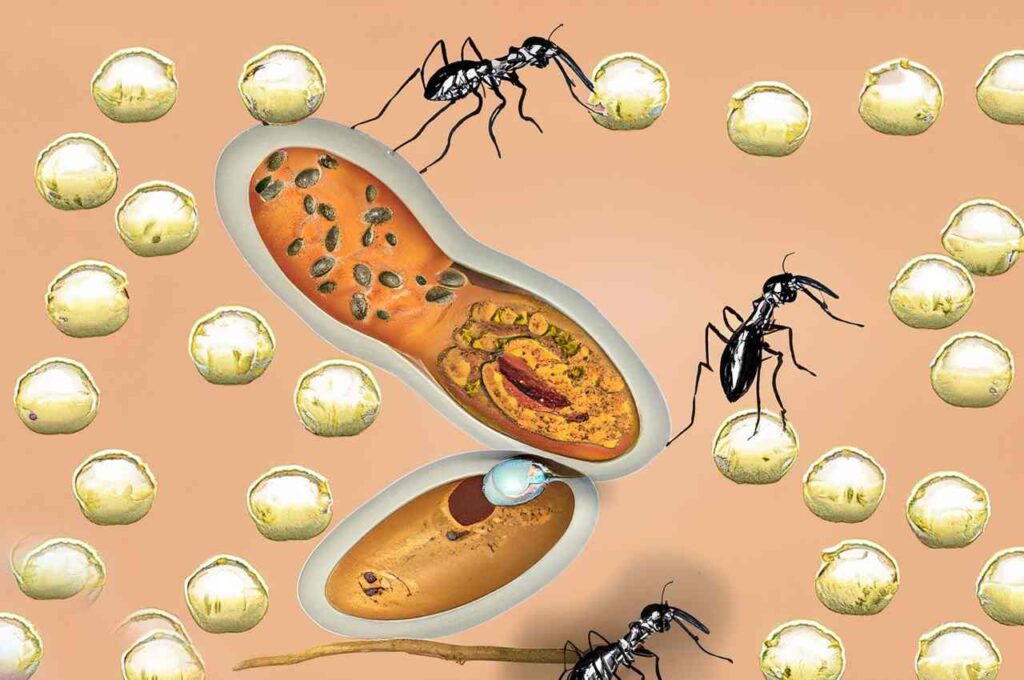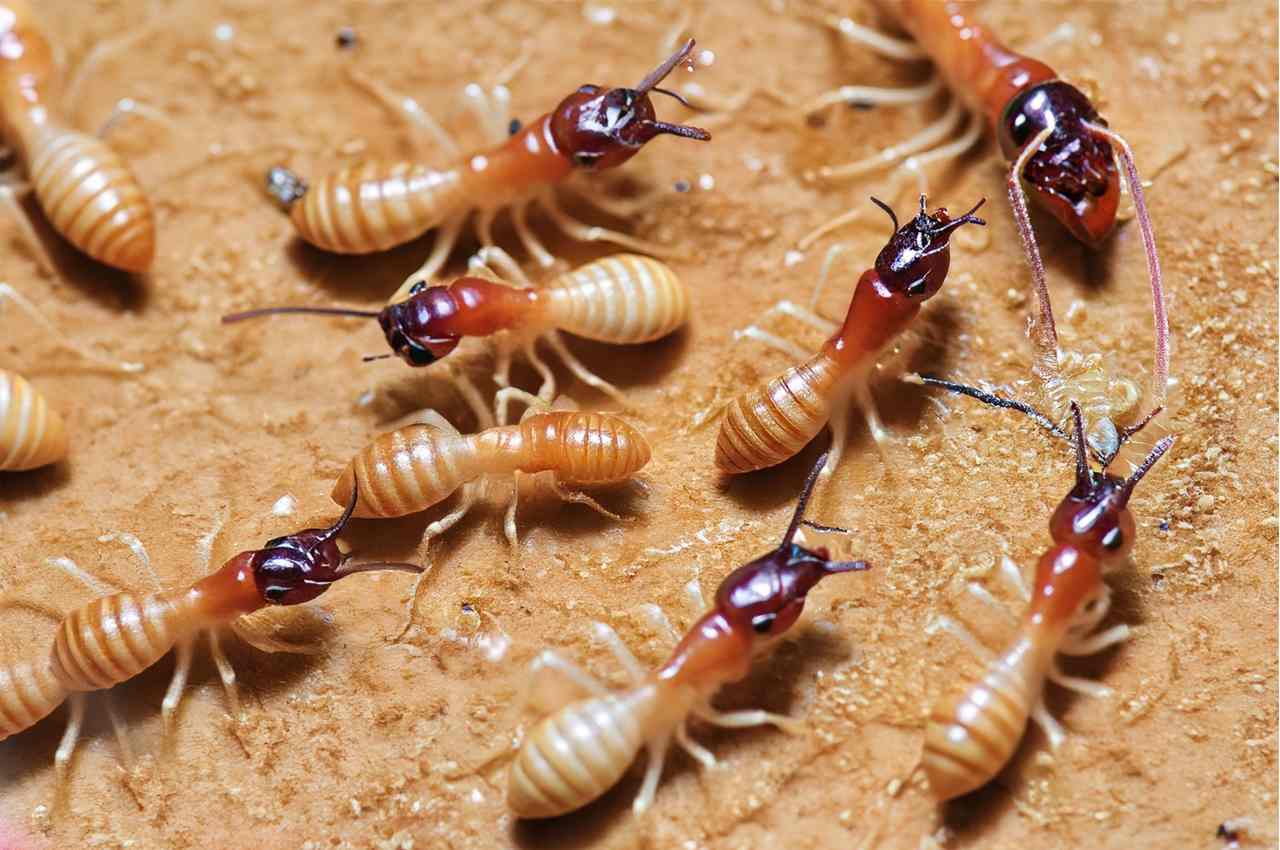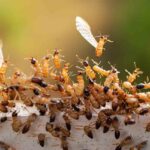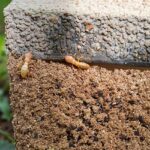“How Termites are Born,” a major part of their life cycle, adds to their reputation as “silent destroyers,” as they damage wood structures. It’s essential to examine the termite life cycle and comprehend how termites are born in order to properly avoid and control termite infestations. In this post, we’ll delve into the intriguing world of termites and provide insightful details on their development and life cycles.
Termite Life Cycle Timeline
| Stage | Duration | Description |
|---|---|---|
| Egg Stage | Several weeks | Female alates deposit oval-shaped white eggs. |
| Nymph Stage | 6-12 months | Newly hatched nymphs resemble small adult termites. |
| Worker Stage | Varies (1-2 yrs) | Nymphs mature into workers responsible for colony tasks. |
| Soldier Stage | Varies (1-2 yrs) | Nymphs develop into soldiers for colony defense. |
| Reproductive Stage | Varies (5 yrs) | Mating reproductives create new colonies. |
Birth and Life Cycle of Termites

Termites go through a complicated life cycle with several phases, including:
1. Egg Stage
The egg stage is when the termite life cycle starts. The female of a reproductive termite couple, also known as an alates or swarmers, deposits eggs in a protected area after mating. These eggs are generally oval-shaped, tiny, and white.
Optimal Conditions for Termite Egg Hatching
| Temperature Range | Effect on Termite Egg Hatching |
|---|---|
| 82–90 °F (28–32 °C) | Accelerates incubation and hatching. |
| Cooler Temperatures | Slows processes and delays hatching. |
2. Nymph Stage
The freshly emerging termites are known as nymphs after the eggs hatch. Nymphs are smaller counterparts of adult termites at this stage but are still developing. They undergo a series of molts during which they shed their exoskeletons to expand.
3. Worker, Soldier, and Reproductive Stages
Nymphs change into several castes as they become older, including laborers, warriors, and reproductives. Foraging, tunnel construction, and feeding the colony are all tasks carried out by Workers. Soldiers defend the colony from dangers. Future kings and queens known as reproductives will ultimately mate and create new colonies.
4. Mating and Colony Establishment
After reaching maturity, the reproductives take part in a nuptial flight during which they depart from their home colony in pursuit of a spouse. Following mating, they lose their wings, create a new colony, and repeat the cycle.
Termite Types and Their Roles in the Colony
| Termite Type | Role in the Colony |
|---|---|
| Alates (Reproductives) | Future kings and queens, responsible for reproduction. |
| Nymphs | Develop into workers, soldiers, or new reproductives. |
| Workers | Forage, construct tunnels, and feed the colony. |
| Soldiers | Defend the colony from threats and predators. |
| Queen | The primary egg-laying individual in the colony. |
Termite birth and infestation prevention
Effective termite control requires a thorough understanding of the termite life cycle. The following are some essential tactics for avoiding termite infestations:
1. Regular Inspections: Conduct routine inspections of your home to look for any mud tubes or harmed wood that might be evidence of termite activity.
2. Moisture management: Termites like wet settings to survive. Make sure your house is properly aired, and deal with water leaks right away.
3. Termite Barriers: To prevent termites from accessing your property, think about erecting chemical or physical termite barriers.
4. Professional Pest Control: For skilled termite treatments and continuous prevention, see a pest control specialist.
You may take preventative measures to safeguard your property against these destructive pests by being aware of the birth process and life cycle of termites. Maintaining the termite-free status of your home requires vigilant care.
In the fight against termites, keep in mind that prevention and early diagnosis are your strongest friends. Keep yourself informed and take precautions to protect your house from these “silent destroyers.”
Frequently Asked Questions
How do termites reproduce?
Nuptial flight occurs when winged reproductive termites, or alates, depart their parent colony to find mates. After locating a partner, they lose their wings, mate, and the female becomes colony queen. The queen termite’s 20-year lifespan of egg-laying is crucial. This egg-laying process creates new termites, including workers, soldiers, and reproductives, expanding the colony. Since she produces all termites, the queen is essential to termite reproduction and the colony’s survival.
How are queen termites born?
Queen termites are born by nuptial flight. This phase involves flying reproductive termites, called alates, leaving their parent colony to find mates. After mating, they lose their wings and become queens of new colonies. The queen’s main job is to lay eggs for 20 years. A worker termite may become a queen without a queen or her pheromones, albeit this is unusual. The colony dies when the queen dies since she is the only egg producer. Still, enough worker termites may seek a new queen to start a new colony.
At what temperature do termite eggs hatch?
Termite egg development is best around 82–90 °F (28–32 °C). Within this range, higher temperatures accelerate incubation and hatching. Cooler temperatures slow processes and delay hatching. Termite eggs need tropical or subtropical temperatures and humidity to hatch.
How many eggs in her lifetime can a termite queen lay?
A termite queen may produce a lot of eggs. She may have over 10 million children and 30,000 eggs every day. The colony’s population growth and survival rely on this remarkable production. The queen will keep laying eggs if all other conditions are appropriate for nest maintenance and growth.
Do termites have full or partial metamorphosis?
Termites progressively change. Their development has no passive pupal stage. Termites grow regularly from egg to nymph to adult. Nymphs originally resemble tiny adults because of this transformation. Most insects like butterflies undergo full metamorphosis with stages.
How long does it typically take a termite to complete its life cycle?
Termites normally take 1-3 years to mature from egg to adult. Over many weeks, eggs are incubated and hatch. Nymphs develop throughout 6–12 months, molting every 6–8 weeks. Fully mature worker termites live one to two years. Reproductives may mate and lay thousands of eggs throughout their five-year lifespan.
Which termite control strategies target the life cycle?
The queen, workers, and soldiers may be removed at vulnerable periods of termite development to disrupt the life cycle. Baits, insecticides, and fumigation diminish nymph populations when they emerge. Destroying egg clutches stops growth. Pest management experts can develop the most efficient integrated pest control techniques for each termite life cycle phase.
How many babies do termites have?
A termite queen may produce 30,000 eggs every day, 10,950,000 per year, or 219 million in her lifetime. However, termite species and colony circumstances determine the actual number. These eggs are placed in oothecae, which contain 10 to 100 eggs. Six to two years after hatching, termite larvae undergo multiple molts before becoming adults. These eggs mostly become worker termites, who labor in colonies, while a lesser percentage become reproductive termites, such as soldiers and kings, who establish new colonies. This extraordinary reproduction ability makes termites destructive, making quick pest treatment vital when infestations are detected.
Are baby termites white or black?
White termite nymphs are termites. These soft-bodied insects have a head, thorax, and abdomen with no wings. They have six legs and two antennas. In termite colonies, nymphs play a significant role in several castes, with workers being the most numerous and responsible for nest building, feeding the queen and other termites, and caring for the young. Soldiers protect against predators, while reproductives produce new colonies. Termite nymphs hatch as soft, whitish, and transparent animals and through many molts to become adult termites with particular colony tasks.
- How do termite mounds help regulate temperature? - 7 January 2024
- 10 Effective Termite Control Methods That Actually Work - 4 January 2024
- How Long Does It Take for a Termite Mound to Form? - 21 December 2023




